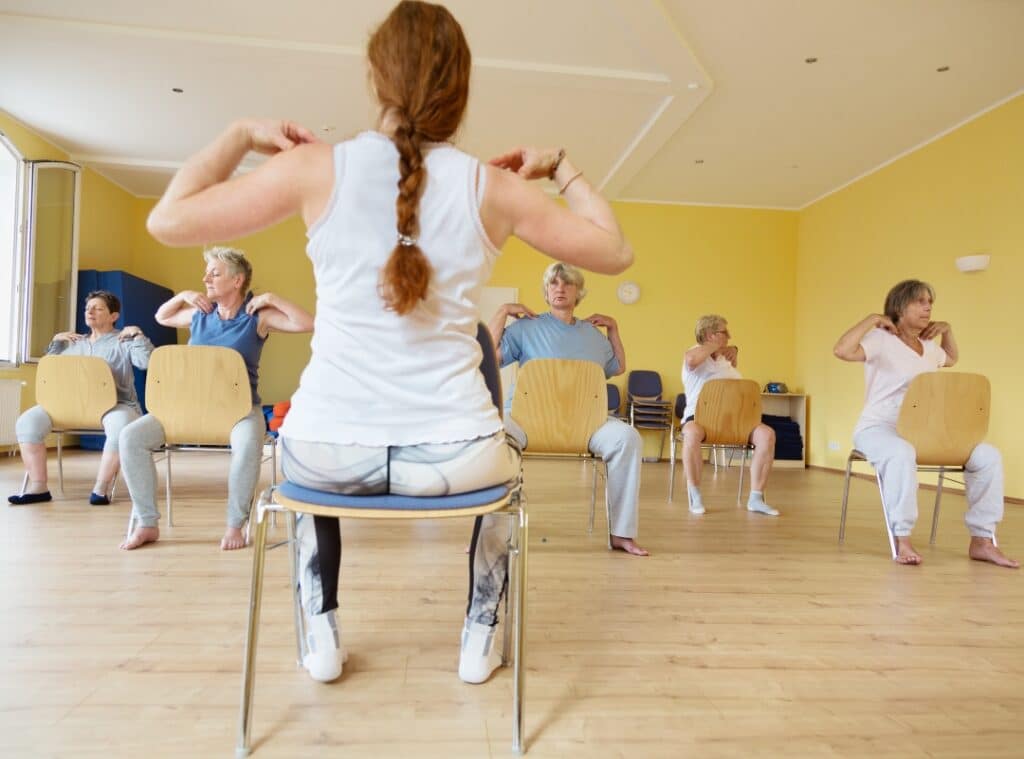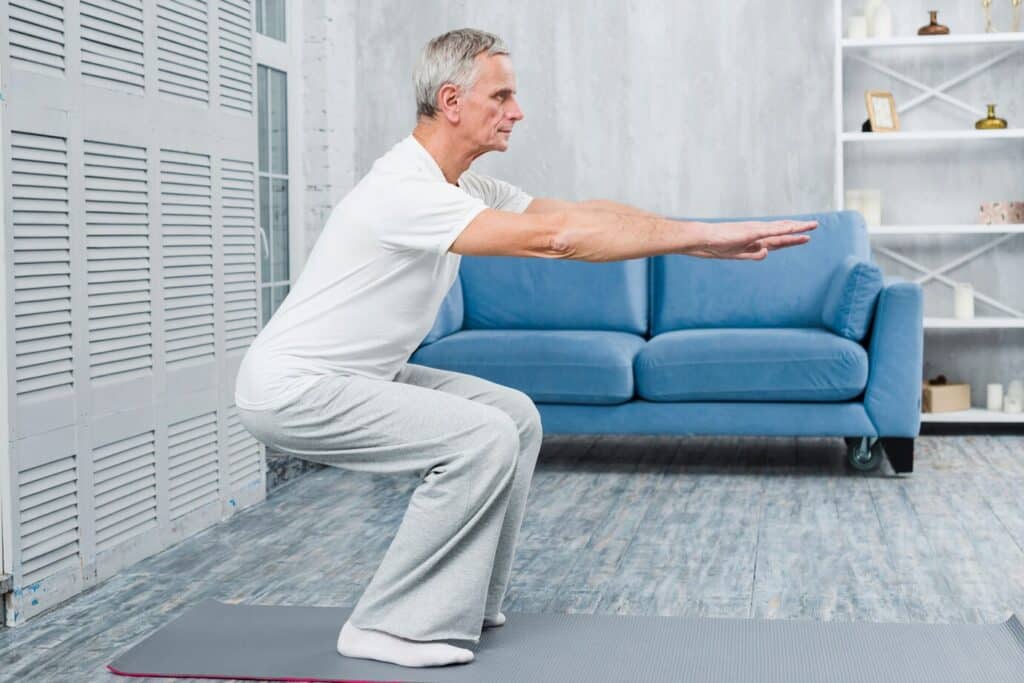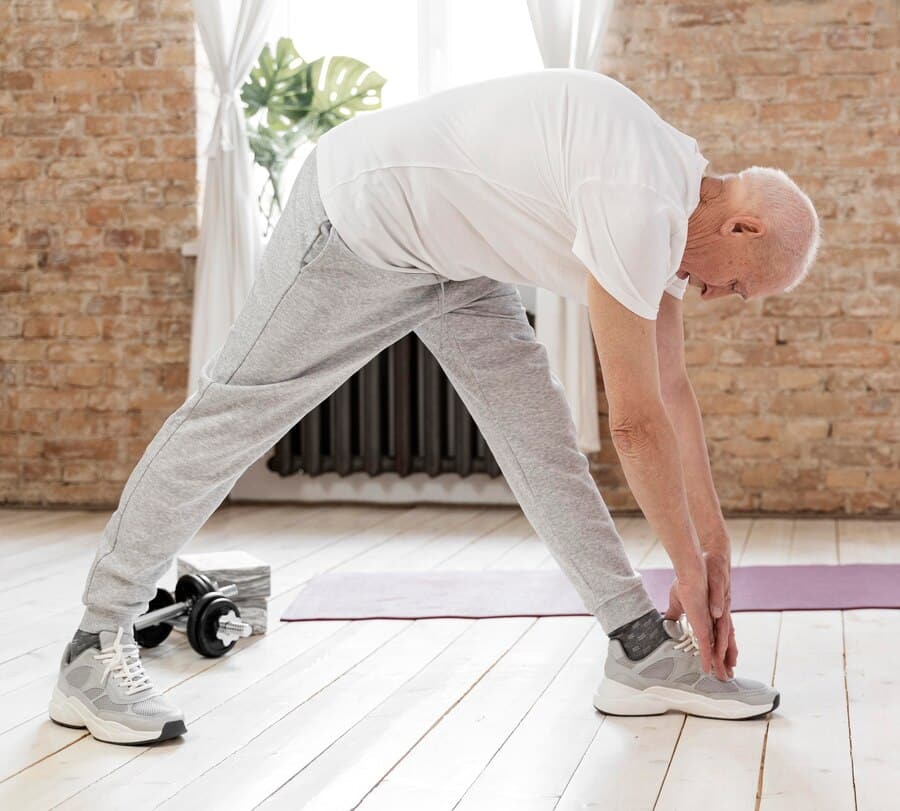Improve your stability and prevent falls with targeted balance exercises tailored for seniors at Lakeview Senior Living. Enhancing your balance is important for daily activities and overall quality of life, reducing the risk of injuries and hospitalizations.
Incorporating regular balance exercises can boost stability, coordination, and confidence. Try basic standing balance exercises, single-leg stands, or dynamic movements like chair-based exercises, yoga poses, or Tai Chi for stability. These activities improve coordination, core strength, and body awareness, all essential for maintaining independence.
Start slow, use support as needed, and track progress for safe and effective balance training.
Key Takeaways
- Start with basic standing exercises for stability and coordination.
- Progress to single-leg stands to challenge balance and strength.
- Incorporate dynamic exercises like leg raises for functional movement.
- Explore chair-based exercises for additional support and safety.
- Consider yoga or tai chi for a holistic approach to balance and stability.
Importance of Balance for Seniors
Ensuring strong balance is vital for seniors as it directly impacts their daily activities and overall quality of life. Balance training is essential in maintaining senior health by reducing the risk of falls and injuries. Our balance declines as we age, making simple tasks like walking or standing more challenging. By engaging in regular balance exercises, seniors can improve their stability, coordination, and confidence in movement.
Senior health is closely linked to balance, as falls are a leading cause of injury and hospitalization among older adults. Strengthening core muscles and practicing balance techniques can enhance stability and prevent accidents. Additionally, maintaining good balance can improve posture, flexibility, and joint health, contributing to an active and independent lifestyle for seniors.
Incorporating balance training into a daily routine benefits physical health and enhances mental well-being. Feeling confident in one’s ability to move safely can boost seniors’ self-esteem and overall quality of life. Prioritizing balance exercises is a proactive approach to aging gracefully and maintaining independence.
Benefits of Balance Exercises
Engaging in balance exercises offers improved coordination and enhanced posture, essential for maintaining stability as you age. Incorporating these exercises into your routine can notably reduce the risk of falls, promoting a safer and more independent lifestyle. Prioritizing balance training can help you feel more confident and secure in your daily activities.
Improved Coordination and Posture
To enhance your coordination and posture, incorporating balance exercises into your routine can make a significant difference. These exercises not only help with stability but also have a positive impact on your overall body alignment and control. Here are three ways balance exercises can improve your coordination and posture:
- Enhanced Core Strength: By engaging your core muscles during balance exercises, you strengthen the muscles that support good posture, leading to better spinal alignment and reduced strain on your back.
- Improved Flexibility: Balance exercises often involve movements that promote flexibility in various muscle groups. Increased flexibility can help you maintain proper alignment and prevent stiffness, which contributes to poor posture.
- Enhanced Body Awareness: Practicing balance exercises enhances your proprioception, which is your body’s ability to sense its position in space. This heightened body awareness translates to better posture control and coordination in daily activities.
Incorporating these balance exercises into your routine can help you maintain better coordination and posture as you age, ultimately improving your quality of life.
Reduced Risk of Falls
Incorporating balance exercises into your daily routine is crucial to diminishing the risk of falls and enhancing your overall safety and independence. Fall prevention is a pivotal aspect of senior health, and stability training through balance exercises can markedly reduce the chances of experiencing a dangerous fall. By engaging in activities that challenge your balance, such as standing on one leg or walking heel to toe, you can improve your coordination and strengthen the muscles that support your stability.
Stability training helps you feel more confident in your movements and enhances your body’s ability to react to unforeseen situations, reducing the likelihood of falls. These exercises promote muscle strength, flexibility, and coordination, vital components in preventing accidents that could lead to injuries.
Basic Standing Balance Exercises
Ready to enhance your standing balance and stability? Basic standing balance exercises are a great way to tackle balance challenges and enhance stability. These exercises are simple yet effective in improving your overall balance and reducing the risk of falls.
Here are three basic standing balance exercises to get you started:
- Single Leg Stands: Stand near a sturdy surface, lift one leg off the ground, and hold for 10-30 seconds. Switch legs and repeat. This exercise helps strengthen your leg muscles and improve balance.
- Heel-to-Toe Walk: Position the heel of one foot directly in front of the toes of the other foot. Take small steps forward, maintaining this position. This exercise enhances your coordination and balance.
- Leg Raises: While holding onto a chair for support, slowly lift one leg to the side and hold for a few seconds before lowering it back down. Repeat on the other leg. Leg raises help improve hip stability and balance.
Incorporate these exercises into your routine to enhance your stability and reduce the risk of falls.
Dynamic Balance Exercises
Get ready to elevate your balance training with dynamic exercises that challenge your stability in motion. Dynamic balance exercises simulate real-life movements and are vital for improving coordination and preventing falls.
Dynamic movements like lunges, side steps, and leg swings engage multiple muscle groups and enhance overall balance and stability.
In the upcoming section, we’ll cover the significance of dynamism and provide practical examples to help you enhance your balance skills.
Importance of Dynamism
Enhancing your balance through dynamic exercises is essential for maintaining mobility and preventing falls as you age. Dynamic balance exercises focus on incorporating movement into your stability training, challenging your body to adapt and react in various situations. Here’s why dynamism is crucial for seniors:
- Enhanced Functional Movements: Dynamic exercises simulate real-life activities, such as walking on uneven surfaces or reaching for objects while standing on one leg, improving your ability to perform daily tasks efficiently.
- Improved Core Strength: These exercises engage your core muscles to stabilize your body during dynamic movements, leading to a firmer and more supportive midsection essential for balance and posture.
- Increased Neuromuscular Coordination: By practicing dynamic balance exercises, you enhance the communication between your muscles and brain, promoting quicker responses and better coordination, which are important for preventing falls and maintaining stability as you age.
Practical Exercise Examples
Incorporating dynamic balance exercises into your routine is key to effectively improving your balance and stability. These exercises can be adapted to your home environment to enhance safety and convenience. Chair modifications can provide extra support as you work on improving your balance. One example is the chair stand exercise, where you slowly stand up from a seated position and sit back down, ensuring proper form and control.
Another beneficial exercise is the single-leg stand, in which you lift one foot slightly off the ground while holding onto the chair for support. The duration of this exercise gradually increases as you build strength and stability.
Additionally, you can try the tandem walk, where you walk heel-to-toe in a straight line, using the chair for balance if needed. This exercise helps improve coordination and balance. Remember to focus on your posture and engage your core muscles throughout these exercises to maximize their effectiveness. Incorporating these dynamic balance exercises with chair modifications into your routine can enhance your stability and reduce the risk of falls in your daily life.
Single-Leg Balance Exercises
Incorporating single-leg balance exercises into your routine can be highly beneficial when improving your balance as a senior. These exercises help strengthen the muscles that support your core and lower body, enhancing stability and reducing the risk of falls. Here are some key benefits of single-leg balance exercises:
- Improved Balance Challenges: By focusing on balancing one leg at a time, you challenge your stability and engage smaller stabilizing muscles essential for balance. These exercises can be a great addition to the top 10 leg exercises for seniors.
- Enhanced Standing Techniques: Single-leg balance exercises can help you feel more confident and steady while standing, walking, or performing daily activities that require stability.
When combined with tailored leg exercises, these exercises can significantly impact overall stability and mobility.
Chair-Based Balance Exercises
Building on the foundation of single-leg balance exercises, chair-based balance exercises offer seniors a practical and effective way to further enhance their stability and reduce the risk of falls.
These seated exercises improve sitting stability and strengthen core muscles, which are essential for maintaining balance and preventing mishaps.
Seated exercises such as leg lifts, knee extensions, and seated marches can help seniors improve their balance while supporting a chair. By engaging in these exercises regularly, seniors can increase their lower body strength, enhance coordination, and boost confidence in their ability to maintain balance during daily activities.
It is essential to safely perform chair-based balance exercises, ensuring the chair is stable and placed on a flat surface. Remember to sit tall properly and breathe deeply throughout the exercises to maximize their advantages.
Incorporating chair-based balance exercises into a daily routine can significantly enhance stability and reduce the risk of falls for seniors, promoting a more active and independent lifestyle.
Yoga Poses for Balance
Enhance your balance and flexibility with a series of yoga poses designed specifically to improve stability and reduce the risk of falls. Incorporating yoga into your routine can have numerous benefits for seniors. Here are some key points to keep in mind:
- Chair Modifications: If you have trouble with balance or mobility, many yoga poses can be adapted using a chair for support. This allows you to practice the poses safely and still reap the benefits of improved stability.
- Mind-Body Connection: Yoga emphasizes the connection between your mind and body, helping you become more aware of your movements and posture. This increased awareness can lead to better balance and coordination as you age.
- Flexibility and Strength: Yoga poses work on flexibility and strength, which are essential for maintaining stability. Regularly practicing these poses can improve your overall physical condition and reduce the risk of falls. Remember, consistency is key in reaping the full benefits of yoga for balance.
Tai Chi for Stability
Exploring the practice of Tai Chi can be a valuable addition to your routine to further enhance your stability and overall well-being. Tai Chi is a exercise that focuses on the mind-body connection through gentle movements. This ancient Chinese practice incorporates slow, flowing motions that can help improve your balance, flexibility, and strength.
Tai Chi is often described as “meditation in motion” because it encourages focus on movements while also calming the mind. By incorporating Tai Chi into your routine, you work on physical stability and enhance your mental well-being.
The gentle nature of Tai Chi makes it a suitable option for seniors looking to improve their stability without putting excessive strain on their bodies. The slow and deliberate movements can help you build strength in a safe and controlled manner.
Consider adding Tai Chi to your weekly exercise regimen to experience improved stability and a deeper mind-body connection.
Tips for Safe Balance Training
For effective and safe balance training, it’s crucial to approach your exercises with a focus on proper form and technique. Preventing injuries and essential forms are critical to maintaining a safe balance training routine. Here are some tips to help you progress safely and monitor your progress:
- Start Slow: Begin with simple balance exercises and gradually increase the intensity as your stability improves. This gradual progression will help prevent overexertion and reduce the risk of injuries.
- Use Support: When trying more challenging balance exercises, have a stable surface or support nearby to grab onto if needed. This extra precaution can prevent falls and injuries while allowing you to challenge yourself.
- Track Your Progress: Record your balance exercises and how you feel after each session. Monitoring your progress will help you adjust your routine accordingly and ensure you advance safely toward your stability goals.
Find Where You Belong
Dive into the vibrant life our Westmont communities have to offer.
Final Thoughts
Incorporating balance exercises into your daily routine can help improve stability and reduce the risk of falls for seniors at Lakeview Senior Living. You can enhance your balance and overall quality of life by focusing on basic standing, dynamic, single-leg, and chair-based exercises and incorporating yoga poses and Tai Chi movements. Remember to always prioritize safety during your balance training and consult with a healthcare professional before starting any new exercise program. Stay active, stay balanced, and stay healthy! Contact Lakeview Senior Living at 541-994-7400 for more information.








